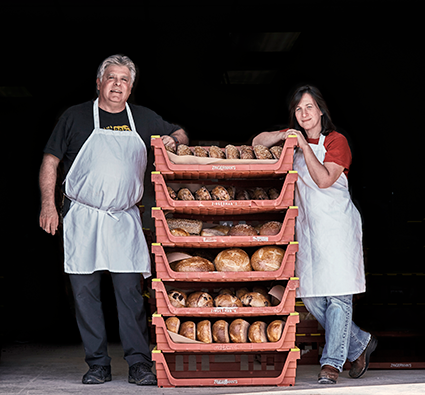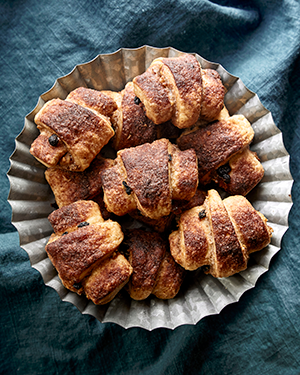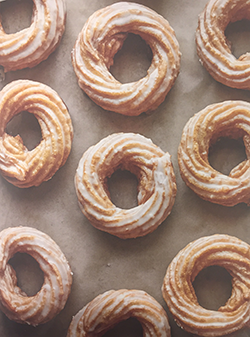Food
Cookbook Review
Holidays
Hanukkah
Zingerman’s Bakehouse of Ann Arbor Debuts First Cookbook

At Zingerman’s Bakehouse in Ann Arbor, Mich., there are no secrets. When head bakers and co-owners Amy Emberling and Frank Carallo decided to finally release the recipes behind their fawned-over cakes, baked goods and to-die-for artisan breads in the much-anticipated Zingerman’s Bakehouse cookbook, they decided not to spare any details about the life of the bakery and its workers—and, most crucially, its treasured recipes.
“By telling the bakery’s story,” they write in the book, “we hope to show some of what is involved in building a locally rooted artisanal business.” Part of their mission involves making a positive impact on their surrounding community, which is dominated by the University of Michigan.
The bakery is part of a 10-business powerhouse—The Zingerman Community of Businesses—that includes a Jewish deli, The Candy Manufactory and the Roadhouse restaurant serving classic American dishes. The (nonkosher) establishments have become a backbone of the greater Michigan community, and over the years they have procured a loyal fan base of customers and friends in the Midwestern college town.
In the cookbook—the must-have Hanukkah gift for the Wolverines in your life—Emberling and Carallo take readers behind the scenes of the bakery to expose the no-frills life of the bakers and staff there. It is part memoir, part cheerful exposé, and yet also a how-to guide for up-and-coming bakers and small business owners. Plus, most importantly, the amazing traditional recipes, tips and tricks culled from 25 years of experience.
There is a range of different baking levels represented here, from basic baked goods such as Big O Cookies (oatmeal raisin cookies sweetened with maple syrup) to complex breads using European-style starters, such as their Chestnut Baguettes. Pastries like rétes are delicious cousins of Hungarian strudel. Zingerman’s brings a little bit Jewish, a little bit Eastern European, a little bit American and a lot Michigan to the baking world with the use of products from local and international artisan businesses.
Their recipes have the same catchy, fun names as they do in the bakery. For instance, the pecan sticky buns are known as Obama Buns—for the full story, you’ll have to buy the book. Background info reveals how certain recipes came to be classics, including one for sour-cream bundt cake created in the 1950s by a group of Eastern European Jewish women—members of Hadassah!—who hoped to revive the yeasted kugelhopf recipe of the Old Country, but veered off course, because who could be bothered with time consuming yeast dough?
The ingredients called for in the book are high quality, and the bakers are not afraid to use real butter, cream and eggs. But don’t be intimidated—substitutes can be made. Moscavato sugar, favored by the team and featured in many of the recipes, can be exchanged with dark brown sugar.
The Walnut and Currant Rugelach recipe, shared here for its iconic place among Jewish desserts, is among Carallo’s “top five temptations at the bakery,” he writes. “They don’t look special, but they pack a really wonderful experience for my palate.” And for the upcoming holiday of Hanukkah, Zingerman’s French Crullers and Chocolate-Covered Glazed Doughnuts are the ultimate treat.

DOUGH
3/4 cup unsalted butter, room temperature
3/4 cup cream cheese, room temperature (preferably Philadelphia’s)
1/2 teaspoon sea salt
1 cup plus 3 tablespoons pastry flour
FILLING
1/2 cup walnuts
1/3 cup plus 1 tablespoon currants
1/3 cup granulated sugar
1 teaspoon ground cinnamon
ASSEMBLY
1/4 cup unsalted butter, melted
1 tablespoon ground cinnamon
1/2 cup plus 2 tablespoons granulated sugar
Make the Dough
- Using a stand mixer fitted with the paddle attachment, cream the butter, cream cheese, and salt. Mix until well combined but not airy. Add the flour and mix until fully incorporated.
- Remove the dough from the mixing bowl and flatten out into an even disk about 8 in [20 cm] in diameter. Wrap in plastic wrap. Refrigerate for at least 30 minutes. The dough needs to chill completely before it is rolled out.
Make the Filling
- Toast the walnuts on a sheet tray in a 325° oven for 10 to 15 minutes, or until they’re a deep golden brown. Let cool, then chop them in a food processor or with a knife until they are the same size as the currants.
- In a medium bowl, mix the walnuts, currants, sugar, and cinnamon together. Set aside.
Assemble and Bake the Rugelach
- Preheat the oven to 350°.
- Remove the dough from the refrigerator and unwrap it. Lightly flour a work surface and place the disk of dough on it. Lightly flour the top of the dough and roll the dough into a 14-inch circle about 1⁄8 inch thick. Keep moving the dough as you’re rolling it to make sure it doesn’t stick.
- Brush the surface of the dough with melted butter and spread the filling mixture on it evenly. With a pastry wheel cutter, cut the dough circle into 16 even, triangular wedges. Starting at the outer edge, roll each piece to the center. The resulting cookie will look like a crescent or a little horn.
- Mix the cinnamon and sugar. Place the rolled rugelach on a parchment lined baking sheet, brush the tops with melted butter, and sprinkle with cinnamon sugar. Bake for 28 to 30 minutes. The rugelach should be golden brown and flaky.
French Crullers
Makes 12 crullers

VANILLA GLAZE
3 tablespoons warm water
1 1/2 tablespoons unsalted butter
1 teaspoon vanilla extract
1 tablespoon corn syrup
1 3/4 cups plus 2 tablespoons powdered sugar
CRULLERS
1/2 cup water
1/2 cup whole milk
1/2 cup unsalted butter
1/2 teaspoon sea salt
1 teaspoon granulated sugar
1 3/4 cups all-purpose flour
4 large eggs
Vegetable oil for deep-frying
Make the glaze
- In a small saucepan, combine the water, butter, vanilla extract and corn syrup. Warm over medium heat until the butter is melted. Stir intermittently. Once the butter is melted, bring the mixture to a boil and then remove from the heat.
- Set up your stand mixer with the paddle attachment. Put the powdered sugar in the mixer bowl and stir on low speed to break up the lumps in the sugar. With the mixer running, pour in the melted mixture. Mix for 5 minutes on low speed.
- The glaze coats the crullers best when it is warm. It can be heated gently on the stove or kept in a double boiler when you are ready to use it.
Make the dough
- Put the water, milk, butter, salt and granulated sugar into a medium saucepan. Set over high heat and bring to a full rolling boil. Melt the butter completely. Remove from the heat and add the flour while stirring with a wooden spoon. Stir until completely combined.
- Return the saucepan to medium heat and continue stirring with the wooden spoon. The process is removing some of the moisture from the mixture. Cook and stir the paste until a film forms on the bottom of the pan.
- Once there is a visible film on the bottom of the pan, remove the pot from the heat and spread the paste along the bottom and up the sides of the pan. Let cool for 3 to 4 minutes before incorporating the eggs. The eggs may cook if the paste is too hot.
- Add the eggs, one at a time, stirring until each is completely incorporated before adding another. The can be done by hand or in a mixer with the paddle attachment. Once all of the eggs have been mixed in, the paste should be thick and smooth. Each time an egg is added the paste will initially look curdled. This is normal. Stir with some force and the egg will become incorporated. Then you can add another egg. After the eggs are incorporated, the paste is ready to use.
Fry and Glaze the Crullers
- Heat 3 inches of vegetable oil to 375° in a deep pan. As you fry the crullers, check the temperature of the oil periodically, because it will drop during the process. You may need to stop frying to let the oil come back to the proper temperature.
- Prepare a pastry bag with a 1/2-inch star tip. Fill the bag with about half of the paste. Do not overfill the bag; it will make it more difficult to pipe your crullers. You can put less paste in the bag if you are concerned about having adequate strength to pipe.
- On 4-inch square pieces of parchment paper, pipe out rings of dough 3 inches in diameter. For best results, hold the tip 2 to 3 inches above the parchment paper. This will help you get a good thickness to your cruller and an even circle.
- Use a slotted spoon or skimmer to gently lower one cruller, parchment and all, into the hot oil. Use your spoon to submerge the cruller in the oil. The parchment paper will release and you can remove it from the oil with tongs. Depending on the space you have available in your fryer, repeat with more cruller rings, but be careful no to overcrowd the pot. The crullers will swell considerably as they fry.
- Fry them for only 20 seconds and then flip them. If they fry too long on their first side they lose the distinctive cruller ridges. The next flip comes when you see cracks forming on the surface of the crullers. Turn again and then fry until they are a nice tan color, slightly darker than golden. Lift the crullers out of the oil with a slotted metal spoon, and drain on a wire cooling rack placed over a sheet tray. Repeat with the remaining crullers.
- Use a large ladle to generously pour the warm vanilla glaze over the crullers. We pour almost five times as much glaze on each cruller as actually stays. This ensure even coverage. The excess glaze will collect on the sheet tray. You will need to reuse the glaze that lands on the sheet tray to complete the process for all of the crullers. Only one side of the cruller is glazed.
Chocolate-Covered Glazed Doughnuts
Makes 8 doughnuts
DOUGHNUTS
1/4 cup unsalted butter, room temperature
1/2 cup granulated sugar
3/4 cup plus 2 tablespoons whole milk
4 teaspoons instant yeast
3 1/2 cups all-purpose flour
1 large egg
1 egg yolk
2 tablespoons Spirytus vodka or other neutral, high-proof alcohol
1 teaspoon sea salt
VANILLA GLAZE
3 tablespoons warm water
1 1/2 tablespoons unsalted butter
1 teaspoon vanilla extract
1 tablespoon corn syrup
1 3/4 cups plus 2 tablespoons powdered sugar
CHOCOLATE GANACHE
1 1/4 cups finely chopped semisweet chocolate
1 cup heavy cream
Vegetable oil for deep-frying
Mix the Dough
- In a stand mixer with the paddle attachment, cream the butter and sugar until smooth. Add the milk, yeast, half the flour, and the whole egg and egg yolk. Mix on low speed until a smooth batter forms. Add the vodka and mix until combined completely. Add the rest of the flour and the salt. Mix until a dough is formed.
- Turn the dough out onto a clean, unfloured work surface and knead by hand for 6 to 8 minutes. The dough will be tacky but smooth. If you prefer to use your mixer, switch to the dough hook attachment and mix on medium speed for 6 minutes. You may need to scrape the dough from the sides of the bowl intermittently.
- Place the dough in a lightly oiled bowl, cover with plastic wrap, and ferment for 1 1/2 to 2 hours, or until doubled in size.
- While the dough is fermenting, prepare the vanilla glaze and chocolate ganache.
- After the dough has doubled, uncover it and turn onto a lightly floured work surface. Fold the dough and place it back into the oiled bowl. Ferment for 1 more hour, or until doubled in volume.
Make the Vanilla Glaze
- In a small saucepan, combine the water, butter, vanilla extract, and corn syrup. Warm over medium heat until the butter is melted. Stir intermittently. Once the butter is melted, bring the mixture to a boil and then remove from the heat.
- Set up your stand mixer with the paddle attachment. Put the powdered sugar in the mixer bowl and stir on low speed to break up the lumps in the sugar. With the mixer running, pour in the melted mixture. Mix for 5 minutes on low speed.
- The glaze coats the doughnuts best when it is warm. It can be heated gently on the stove or kept in a double boiler when you are ready to use it.
Make the Chocolate Ganache
- Place the chopped chocolate in a mixing bowl.
- In a small saucepan over medium-high heat, bring the cream to a full boil. Remove the cream from the heat and pour over the chocolate. Let stand for 3 minutes and then whisk until the chocolate is completely smooth.
- If using right away, let the ganache thicken enough that it covers easily but doesn’t pour right off the doughnut. If you make it ahead of time, warm the ganache gently until it is the perfect thickness for coating. Use a double boiler or be very attentive to it in a pot on the stove, stirring frequently.
Roll and Cut the Doughnuts
- After the second fermentation, lightly flour the work surface and turn the dough out from the bowl. Lightly flour the top of the dough and pat it out to 1/2-in thickness with flat hands, or roll out with a rolling pin. Brush off excess flour after the dough is the desired thickness.
- With a 3 1/2-in doughnut cutter (one that makes a hole), cut out the doughnuts. Place on a lightly floured surface. Cover lightly with plastic wrap so that the exterior of the doughnuts does not dry out and proof for 30 minutes.
- The doughnut holes and scrap dough can be proofed and fried. Do not attempt to rework the dough because it will become tough.
Fry and Finish the Doughnuts
- Heat 3 in of vegetable oil to 375° in a deep pan.
- To fry the doughnuts, carefully lower the proofed pieces of dough into the hot oil. The number of doughnuts you fry at once depends on the size of your fryer. Do not crowd the frying pot.
- Fry the doughnuts on the first side for 1 to 2 minutes, or until golden brown. With tongs, turn the doughnuts over and fry on the second side for 30 to 60 seconds, or until golden brown. Remove the doughnuts from the fryer and drain on a wire cooling rack placed over a sheet tray. Fry all the doughnuts before glazing.
- To glaze the doughnuts, ladle a large quantity of warm vanilla glaze over each doughnut so that it will cover evenly. When you run out of glaze, recover what has dripped onto the sheet tray and reuse it. If it has cooled too much to pour easily, reheat it gently in a microwave and start the process over. Glaze only one side of the doughnuts.
- When the glaze is set, ice the doughnuts with the chocolate ganache. Once again, place the doughnuts on cooling racks set on a clean sheet tray. Use a ladle to pour a generous amount of warm ganache over each doughnut. If necessary, use a butter knife to spread the ganache evenly. As with the glaze, if you run out of ganache, reuse some that has dripped onto the sheet tray.
From Zingerman’s Bakehouse by Amy Emberling and Frank Carollo, photographs by Antonis Achilleos (Chronicle Books, 2017).











 Facebook
Facebook Instagram
Instagram Twitter
Twitter
Rachel H. says
If you keep writing these glowing reviews, I’m going to have to buy all the cookbooks in all the land!
Linda Cohen says
A must-stop
Everytime i’m in ann harbor.
Love this piece and love the place.